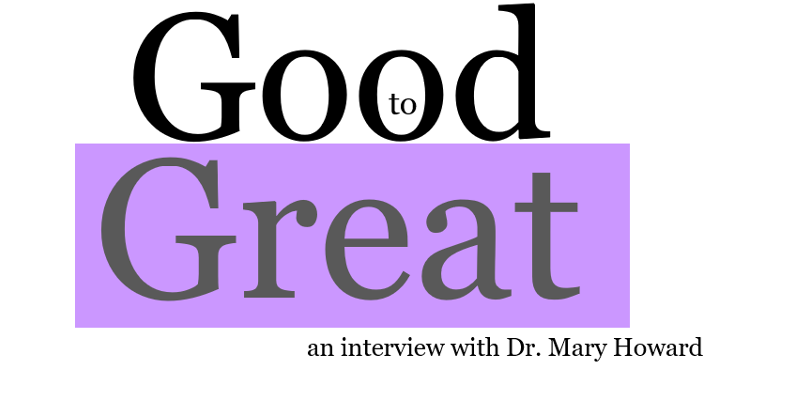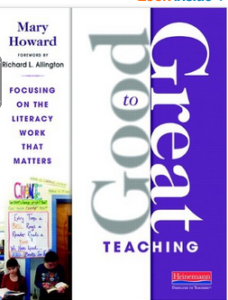One of the huge benefits of social media is the opportunity it provides to form relationships with great leaders in the field of education. Shortly after I created a Twitter account, I came across a multitude of passionate, powerful tweets from Dr. Mary Howard. Dr. Howard is an outstanding educational consultant and author known for her practical approach to putting research into action when training teachers.
I bought her books, devoured their content and contacted Mary with questions about supporting teachers in their work to create independent readers and writers. She was kind enough to agree to an interview about her latest book, Good to Great Teaching: Focusing on the Literacy Work That Matters so that I could share her wisdom with those of us who work every day to collaborate with teachers who do the important work of teaching reading and writing.
Could you talk about a few small steps teachers could take to generate a vision statement that would increase the amount of reading, writing and purposeful discussions students engage in daily?
First step—start from the ground up. What really matters is that children read and write every day. The root of everything I do springs from this–it’s the basis for my day so everything revolves around this. I heard Kelly Gallagher share that someone asked, “What do you do if you don’t have time for write-aloud every day?” His answer, ”Then I don’t do those other things.”
You must start with what you believe. You start with a commitment to student reading, writing, discussing. I want those things to be the heart of everything I do. How do we marry reading, writing and talking to everything else we do instructionally and find a way to inseparably intertwine them throughout the day. In Social Studies if we’re talking about an event in history, then we make sure that reading, writing, and talking abound in that content area. The mistake we make too often is to segment the instructional day when active literacy should work in concert. Building a culture of reading, writing, and discussing texts is not about creating a schedule where we simply plug isolated goals. These are at the heart of everything we do, every day, all day long.
You suggest in your book that teachers should ask themselves a few questions—what do I value? What do I stand for? What are my non-negotiables? If teachers have a hard time answering those questions, what suggestions do you have that would provide a little kick in the rear?
Take time to write this down. Some teachers take time and effort to frame their vision statement and hang it prominently in the classroom. Have a vision for what you believe with actionable goals that show how this important work gets done daily in your classroom.
Two things are critical: Knowledge of good literacy and knowledge of students. Until children are actively, meaningfully engaged in reading, writing, talking around great literature, then we are NOT doing what’s best for them. Powerful literacy practices must rule the day. Unless I’m willing to say no to AR, worksheets, or other “junk” and yes to what research says about literacy then I will inevitably end up standing for the wrong things. One of the ways you make sure you stand firm in regard to your vision is by making time in your day for reflection. The other critical key to holding tight to your vision is to have people in your life that you talk to about what you believe.
We must all stop standing up for fluff, especially at a time when the internet places it right at our fingertips and scripted programs are the norm. Stand up for the non-negotiables–the things that will actively engage students in enthusiastic literacy experience that immerse them in wonderful books. When you reflect, ask yourself, “How did that go? What could I have done differently?” Think back on the practice and compare it to what you said you believe in. “Is my practice daily in line with what I said I believe? If my students are staring at a computer screen I cannot delude myself into thinking that they are actively engaged with both teacher and self-selected texts and opportunities to discuss great ideas with other students”
Even if other work is mandated by the state, my district, my campus I ask myself, “How do I work within the guidelines and still do what I know is best for children?”
Teachers should decide on overarching goals once they clearly articulate their vision statement. How many goals are sufficient? How many might be too ambitious?
When we’re first starting to create the overarching goals, I would encourage teachers to create one goal such as “Children need ample opportunity to learn and read and discuss in small group settings”. Then that is the goal I work toward with great diligence.
If my goal is high quality materials, then I choose that to go after as my consuming goal for the time.
Whatever I choose, I must by fueled a sense of urgency. What is that big goal in my classroom that warrants that sense of urgency? When I’ve identified it clearly, I’m going to dig my feet in and I’m going to devote my energy to this until it’s well established. What if I say that kids should read and write and talk everyday but don’t have the adequate resources? Then the overarching goal is to create a classroom library so that students have what they need to read and write and talk every day.
In your book, it’s clear that you were coaching teachers through this process. What would you encourage teachers to do that don’t have access to an instructional coach, mentor or the actual author of this book guiding them through the goal setting process?
Find someone that you can talk to and collaborate with and learn alongside. Create a visual gallery of their step by step processes. Document your own journey toward creating lifelong readers and writers. If we can’t see the progress we’re making, we assume we haven’t done an adequate job of implementing our goals. Write it in a notebook, collect pictures of what you’re doing to get validation. Teachers get frustrated when they have a goal and work hard, but don’t feel like they are getting where they want to get. We have to celebrate every step we are making toward success of achieving that goal. That takes it from being overwhelming to achievable. Videotape yourself so that you see the progress you’re making. Here’s what I want to look for (this one thing). Only watch for the ONE thing. Reflect on appropriate changes you want to make.
If my overarching goal, my vision, is to have kids read, write, and talk then I use that as the filter for planning my lessons. When I create a sense of urgency ZOOM LENS it’s easy to discard the stuff that I don’t stand for.
Any final words of wisdom you would share with teachers who are committed to focusing on the literacy work that really matters?
This belief is now tattooed on my heart. I won’t do it sometimes, I’ll persist and make sure I do it every day, in lots of ways: Are my students reading, writing, discussing great texts? I can’t veer a little off course and still stay true to what I know is best for kids. I will follow what the district or state mandates until it causes me to leave the course of my vision and deep beliefs. If I say I’ll do this BUT my actions show otherwise, I must apologize because I am not holding true to what I know is best for children. If I say you don’t have time, then you just get rid of those things that matter little and make the time for what matters a great deal. What you value most, you will hold dear and MAKE the time—do it no matter what.
Thank you, thank you to Dr. Mary Howard for her commitment to research-based practices that make the greatest impact on our young readers and writers. If you don’t already follow Dr. Howard, you can connect with her on Twitter @DrMaryHoward and on her website here: http://www.drmaryhoward.com/
Dr. Mary Howard, author of RTI from All Sides: What Every Teacher Needs to Know (Heinemann 2009) and Moving Forward with RTI: Reading & Writing Activities for Every Instructional Setting and Tier (Heinemann, 2010) and Good to Great: Focusing on the Literacy Work That Matters (Heinemann 2012), is known for her no-nonsense approach and engaging style. Her focus on translating research into practical application provides teachers with instruction tools they can use immediately.
— http://www.drmaryhoward.com/












Val, What an amazing post! Thank you for sharing this. I completely connect with you in your description of connecting w/Mary on Twitter and the power of social media. I still pinch myself regularly when I stop to think about the professional relationships I have that were birthed out of Twitter. It is simply incredible. I have enjoyed seeing you and exchanging Tweets in Good To Great & Simple Starts.